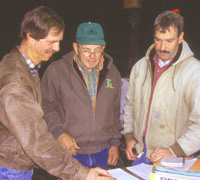|
| |

CSP Success Story: Ed Halter, Robinson, Illinois

(from left) NRCS district conservationist
John Pearse, Ed Halter, and his son-in-law Jeff Rich |
Ed Halter, an outstanding conservation farmer in Illinois’ Wabash Watershed, is
also a Tier II, category A Conservation Security Program (CSP) contract holder
putting him close to the top of the heap when it comes to points for outstanding
stewardship. Practices found on his 833-acre CSP farm include acres of grasses,
filter strips, grassed waterways, buffers, conservation tillage and no-till, a
concrete block chute, drop boxes that slow the course of runoff water, and
terraces galore. Halter’s land in Crawford County has soil that is heavy with
clay, which makes agriculture a challenge. Although clay soils can be difficult to work,
they also restrict the movement of water — Ed’s primary goal on his land.
He has done this over the years by installing drainage tile that gathers,
directs, and manages water on his fields. Ed installed nearly 400,000 of the
800,000 feet of tile on his farms himself. Why is controlling water so
important to him? Because soil erosion is not an option for Ed.
He has also been involved with the
Environmental Quality Incentives Program
for years and he’s also worked with a number of State conservation programs. So
when the CSP came along and he heard it was designed to reward conservation
farmers for the good things they’d done on their land, he naturally looked into
it.
“We went to the NRCS office and talked to our district conservationist John Pearse about it,” says Jeff Rich, Halter’s son-in-law. Jeff helps Ed manage the
land.
“They just needed information on things we were already doing,” adds Rich. Ed
already had all the documentation and records NRCS needed. All the soil samples
were up to date.
Since he bought his first ground, Ed has partnered with the NRCS to protect his
land. “I’ve always worked with NRCS because they give me good guidance and good
ideas,” says Halter. “Together, NRCS and I come up with some pretty good
solutions,” Ed adds. Over the years, he and his family have used many different
NRCS conservation programs to help get solutions on the ground. “I like working
with NRCS.”
Your contact is Paige Buck, NRCS
public affairs specialist, at 217-353-6606.
| | |
